Pasta Primavera is a beautiful spring vegetable pasta made famous by Le Cirque, a swanky French restaurant in New York. I visited Le Cirque many years ago as a youngster and the memory of this swoon-worthy pasta has always stayed with me. This is the actual recipe from Le Cirque! You will love it.
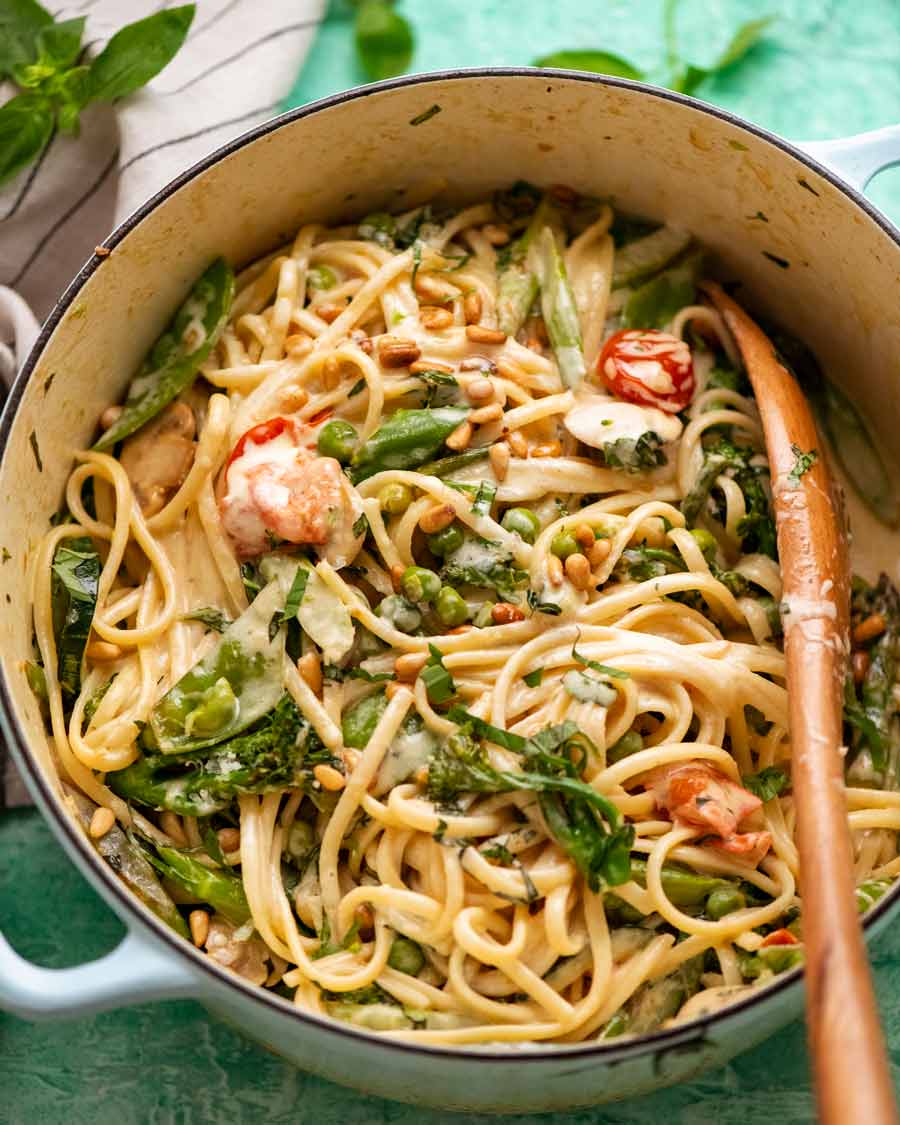
Pasta Primavera
Today’s recipe is a big, wholesome vegetable fix disguised in the form of a creamy pasta. So you can pitch it to your clan as a decadent creamy pasta for dinner but know that there’s also a good hit of nutritious vegetables in it too. Life is all about balance, after all!
Primavera means “spring” in Italian, and this meatless dish is all about celebrating the best green bounty the season offers up. In this spirit, don’t feel bound by the vegetables I’ve used! Use the best seasonal spring produce you find, or check out my recommendations for substitutions.
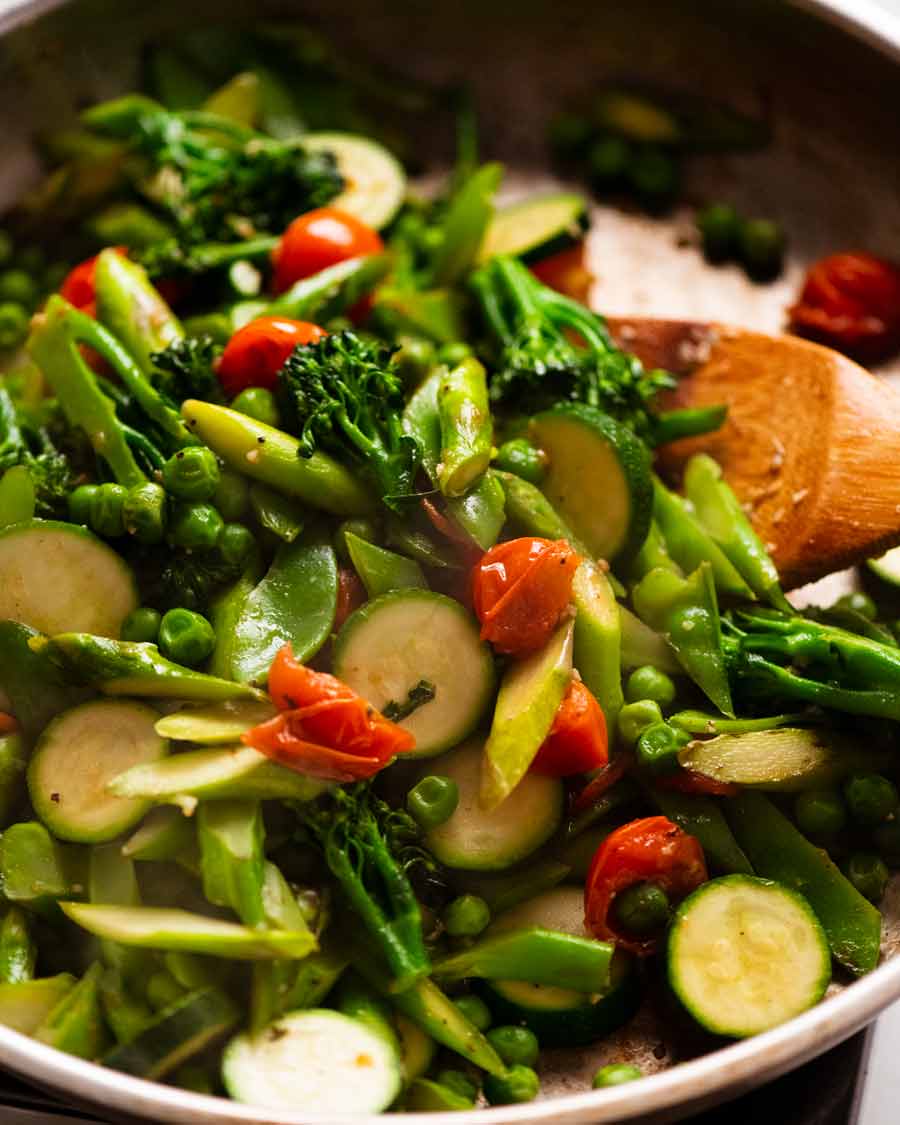
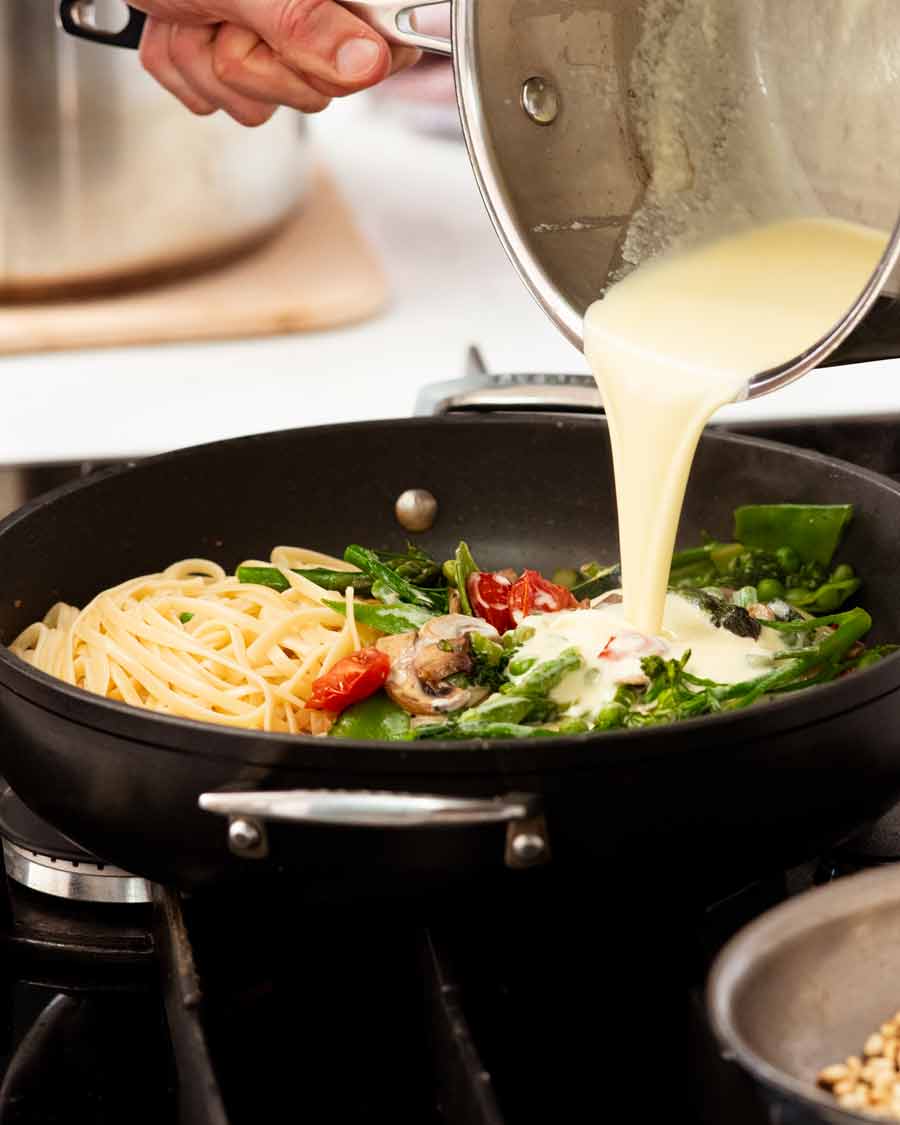
The Pasta Primavera story
It is said that this pasta dish was invented in the 1970’s by Sirio Maccioni, the restaurateur behind Le Cirque, a renowned French restaurant in New York City (now closed). I will always have fond memories of Le Cirque. It was the first and only top-end fine dining restaurant I had the luxury of dining at when I travelled to NYC as a broke uni student. My entire trip food budget evaporated in one dinner at Le Cirque, such were the prices (hot dogs and pizza slices it was for the rest of the trip!) But for this starry-eyed greenhorn new to the world of fine dining, it was worth every penny.
Of all the amazing dishes I savoured that night, Pasta Primavera is still burned in my mind as the standout. Invented as a dish to celebrate spring produce, there are now many versions of Pasta Primavera around. While researching a recipe for Pasta Primavera, Chef JB and I discovered the origins of the dish could be traced back to Le Cirque, and were able to hunt down the actual recipe from Le Cirque. So it seems sharing the original recipe in all it’s perfect glory is just meant to be!
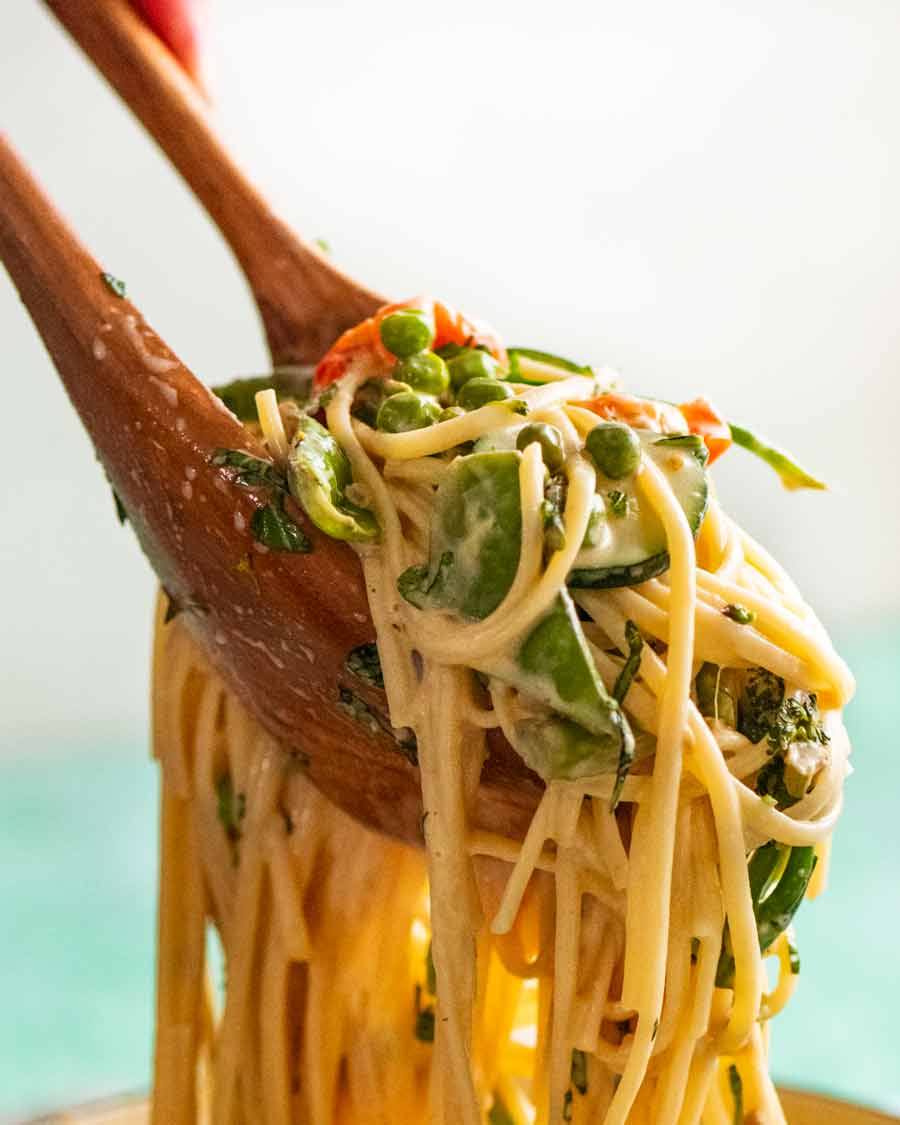
What you need for Pasta Primavera
1. The vegetables
The vegetables I used in this recipe are as per the Le Cirque restaurant recipe. They’re mostly spring vegetables, as explained. However, absolutely feel free to switch and change to your tastes and/or what’s in season where you are!
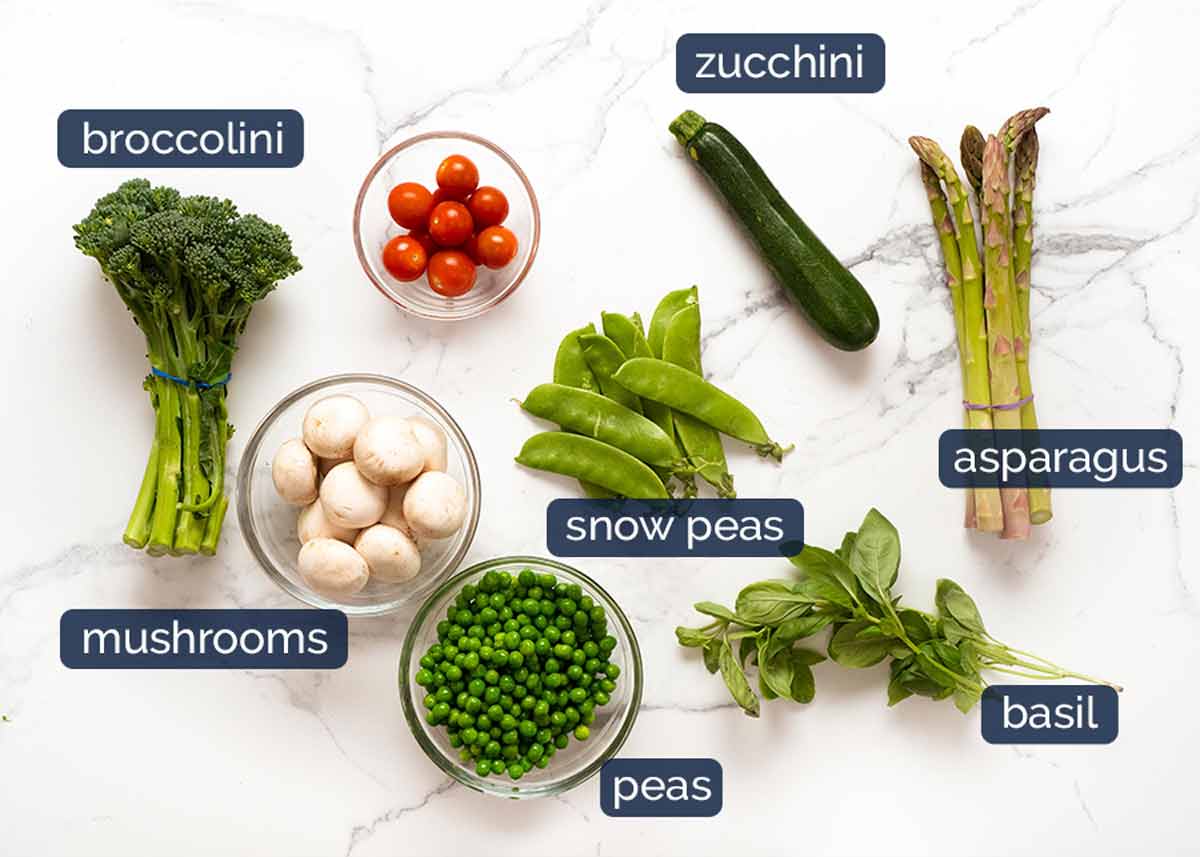
For each vegetable, I’m including suggestions for substitutions for similar vegetables. However, you can always just use more of another vegetable already in the recipe – or not. Make this dish your own!
-
Broccolini – With longer, thinner stalks than regular broccoli, the natural shape of broccolini is a perfect for tossing through long strand pasta. Substitute: Regular broccoli cut with more stem than you ordinarily would include, stems cut into long thin wedges or thick batons. ie try to mimic the shape of broccolini as best you can.
-
Cherry tomatoes – Or cut regular tomatoes into chunks.
-
Mushrooms – Any kind sliceable! If you only have large ones (like portobello) then just slice and chop into pieces so they are a similar size to slicing mushrooms around 3.5cm / 1.5″.
-
Snow peas – Substitute with green beans, trimmed and cut in half lengthwise.
-
Zucchini – Carrot probably gives the most similar texture in the end result.
-
Asparagus – More broccolini or zucchini are probably the best substitutes for this.
-
Peas – Just frozen is totally fine in my books. Frozen peas really are better than old fresh peas. If you have home-grown-garden-fresh-organic-peas you’ve shelled yourself, I want to be you. 🙂
-
Basil – A handful of fresh basil really adds that taste of warm weather brightness to this dish. But if you don’t have it, just leave it out because this recipe is absolutely still worth making. Substitute: I’d probably add a touch of fresh lemon juice instead, for a touch of freshness.
2. Sauce and pasta
This recipe I’m sharing today is the original as sourced from Le Cirque restaurant in New York City. So it is unapologetically luxurious with a good whack of butter and cream, giving it that truly restaurant-quality finish. I’ve added a note in the recipe for the best way to lighten it for the calorie-counters out there!
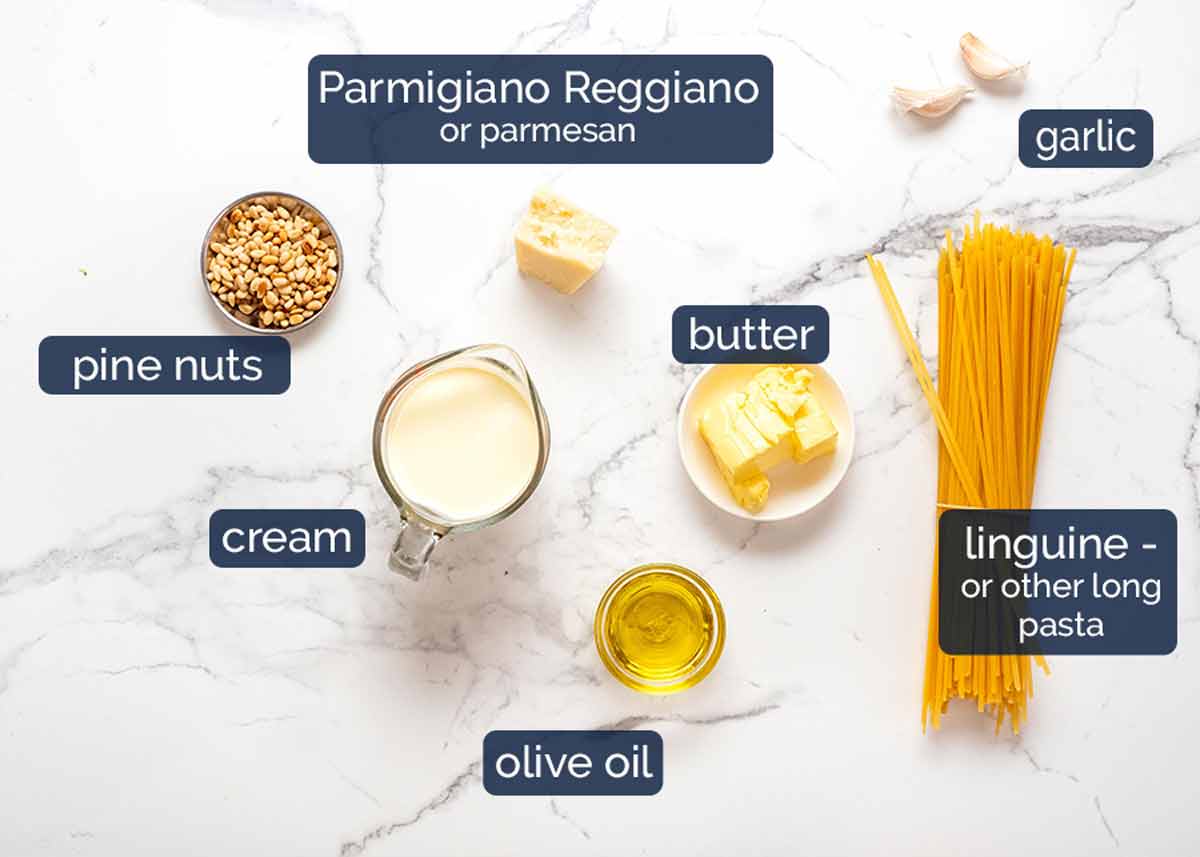
-
Pine nuts – This is the signature ingredient that’s a hallmark of Le Cirque’s version. It adds a distinctive flavour and texture that really makes this recipe unique. I urge you not to skip it!!
-
Parmigiano reggiano – This is true parmesan cheese, with a firm and dry texture perfect for finely grating over dishes and stirring in so it melts into sauces like this. It made according to strictly-regulated Italian methods and is aged a minimum of 24 months, giving it a more complex flavour than regular industrially-produced parmesan cheese.
Substitute with non-reggiano parmesan or grant padano. But you MUST finely grate it yourself! If you buy pre-grated the grains are too large and usually coated with anti-caking agent so it won’t melt smoothly into the sauce.
-
Cream – For the sauce. Thickened / heavy cream is best though regular cream also works. As for low fat? Well, it’s still good but obviously changes the end result. The mouthfeel is less full and rich, and the sauce won’t be as thick so it won’t cling to the pasta as well.
-
Butter – Melted and stirred into the sauce.
-
Garlic – To add tasty flavour to the sautéed vegetables.
-
Olive oil – For cooking the vegetables.
-
Linguine or fettucine. Other long strand pastas also work fine but I do think that flat pastas like linguine work best because the bigger surface area means more sauce cling!
How to make Pasta Primavera
The key to making Pasta Primavera well is to sauté the vegetables in the right order so they all end up perfectly cooked at the same time. Nobody wants soggy, floppy, dull vegetables in their Pasta Primavera! We want perky, green and vibrant vegetables – spring is about the new and fresh remember!
1. Cutting the veg
I won’t cover cutting all the vegetables. Just the ones sliced in non-typical ways (but it’s not hard, I promise!)
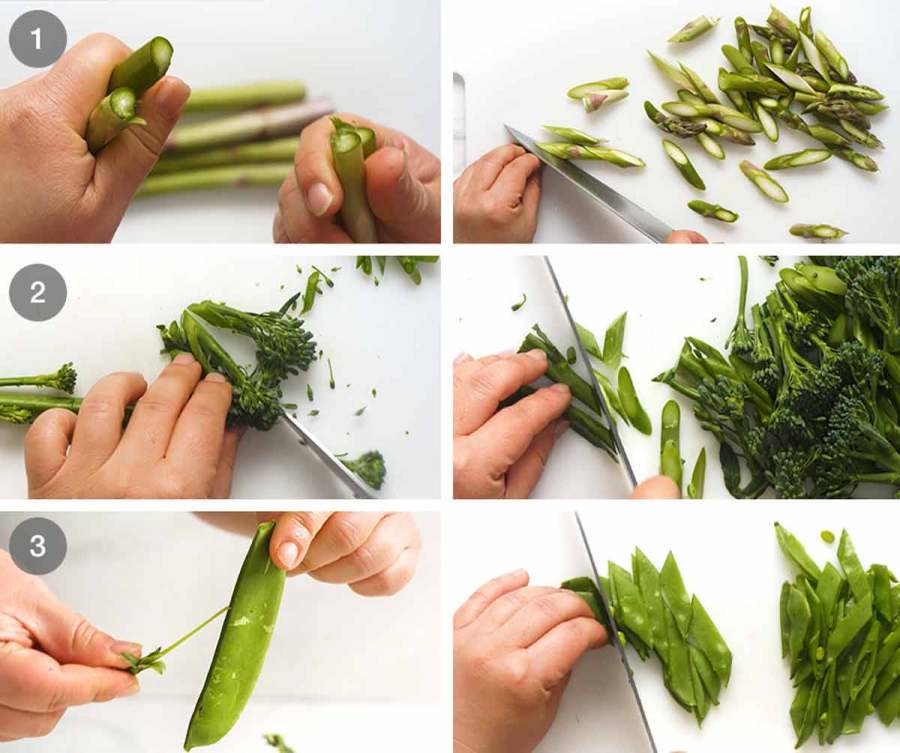
-
Asparagus – Grab a few and snap the base off with your hands. Asparagus will naturally break at the point of the stringy woody base starts that we don’t want. Handy tip! 🙂
Cut off the top 3cm / 1.2″ tips and set aside. Then slice the stems on the diagonal into 2.5 cm / 1″ lengths.
-
Broccolini – Cut off the bushy florets with enough of the stem so you don’t end up with a mess of floret falling off everywhere. Then split the floret in half lengthwise (or quarter if you have abnormally fat ones).
Slice the stems on the diagonal into 2.5 cm / 1″ lengths.
-
Snow peas – Pinch off the stem end with your fingers then pull downwards to remove the tough “string” running along the “seam” side of the snow pea.
Slice and slice – Stack 2 or 3 snow peas then slice on the diagonal around 1 cm / 0.4″ wide.
2. Cooking
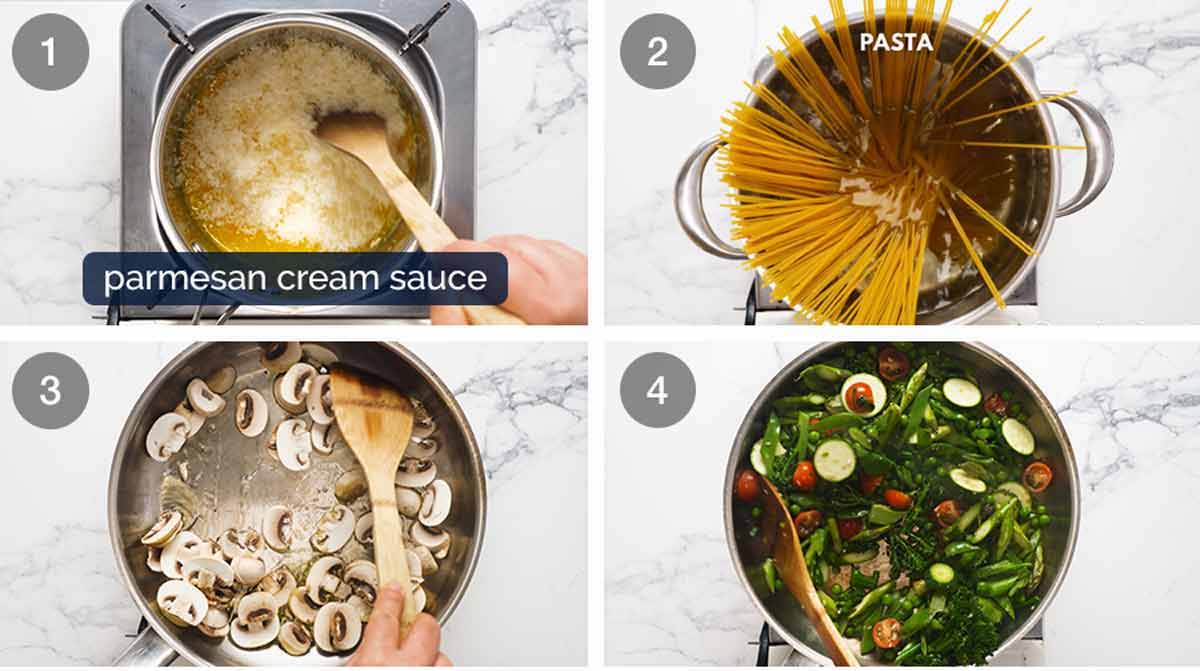
-
Sauce – Melt the butter in a saucepan, and add cream and parmesan. Bring it to a simmer and stir just to melt the cheese, then turn off the stove and set aside. The sauce will seem thin but it will thicken later when we toss through the pasta with a splash of pasta cooking water (see step 7)
-
Cook pasta – Start the pasta at this point. This way, the pasta and vegetables should be done around the same time to bring the dish together.
-
Mushrooms – In other pan, sauté the mushrooms in half the oil until light golden, remove from the pan and set aside. (Don’t try to cook the mushrooms with the other vegetables, they will just stew and go watery!)
-
Cook green veg – In the same pan, heat the remaining oil and cook the broccolini, snow peas and asparagus together for 2 minutes. Then add the zucchini, tomato, peas and garlic and cook for 3 minutes.
By this time, all the vegetables should be almost cooked with a slight bite to them still. By the time we finish tossing with the sauce they will be crisp-but-tender, the perfect doneness where the vegetable are cooked but retain some texture. It’s the point at which vegetables are at their most vibrant and sweetest when cooked!
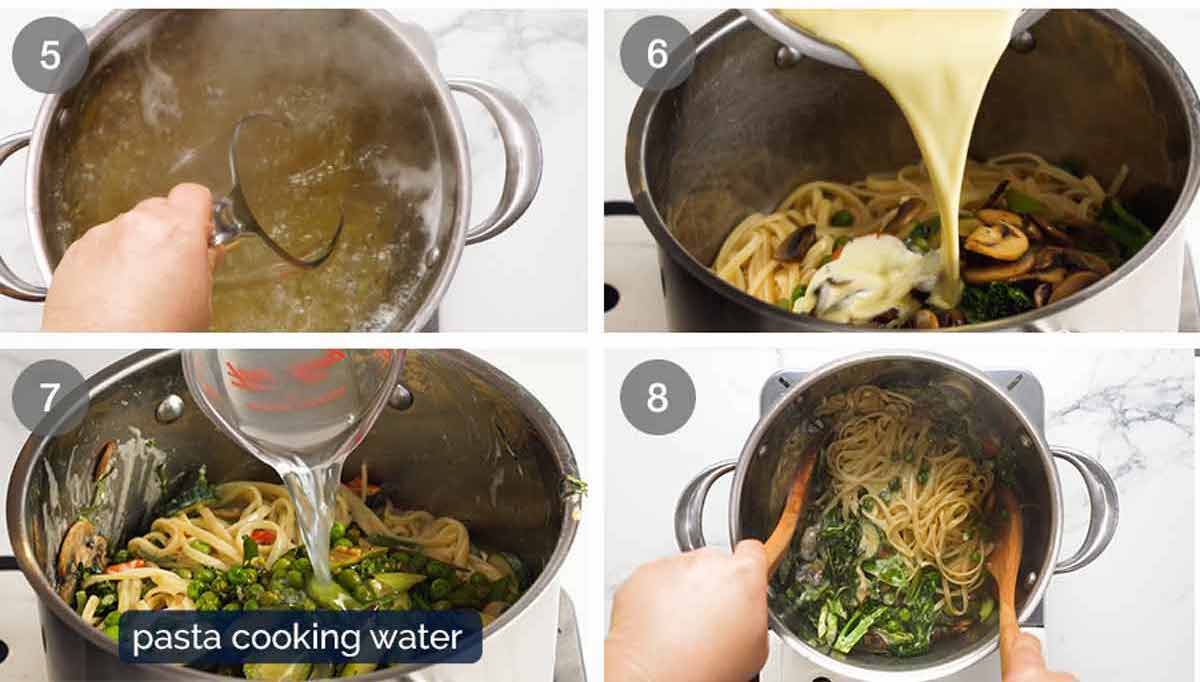
-
Reserve pasta water – Just before draining the pasta, scoop out a mugful of the cooking water. This is our secret weapon for thickening the sauce, read Step 1 above for an explanation.
-
Sauce and vegetables – Return the drained pasta back to the empty pasta cooking pot. Then add the vegetables plus creamy sauce.
-
Pasta cooking water – Add 1/3 cup of the reserved pasta cooking water. What happens now is that the starch in the pasta cooking water thickens the sauce so it coats the pasta strands. It also emulsifies the sauce (ie. helps fats and water mix), like how when you shake oil and vinegar to make a salad dressing and it magically becomes uniform and viscous!
-
Toss over heat – Turn the stove up to medium. Toss the pasta for 1 to 2 minutes until the cream sauce has thickened and is clinging to the pasta strands rather than being watery and pooled at the bottom of the pot.
Basil & pine nuts – Right at the end, quickly toss through the basil just to disperse, then serve in bowls sprinkled with the pine nuts.
Serve the pasta up immediately! Creamy pastas stay at peak eating for only a short time. The longer you leave it sitting around, the less creamy and silky the sauce will be. The sauce will tend to congeal as it cools, and also gets absorbed by the pasta, making it the dish gluggy. If this happens, just add a splash of pasta cooking water and toss again on the stove to loosen it up again!
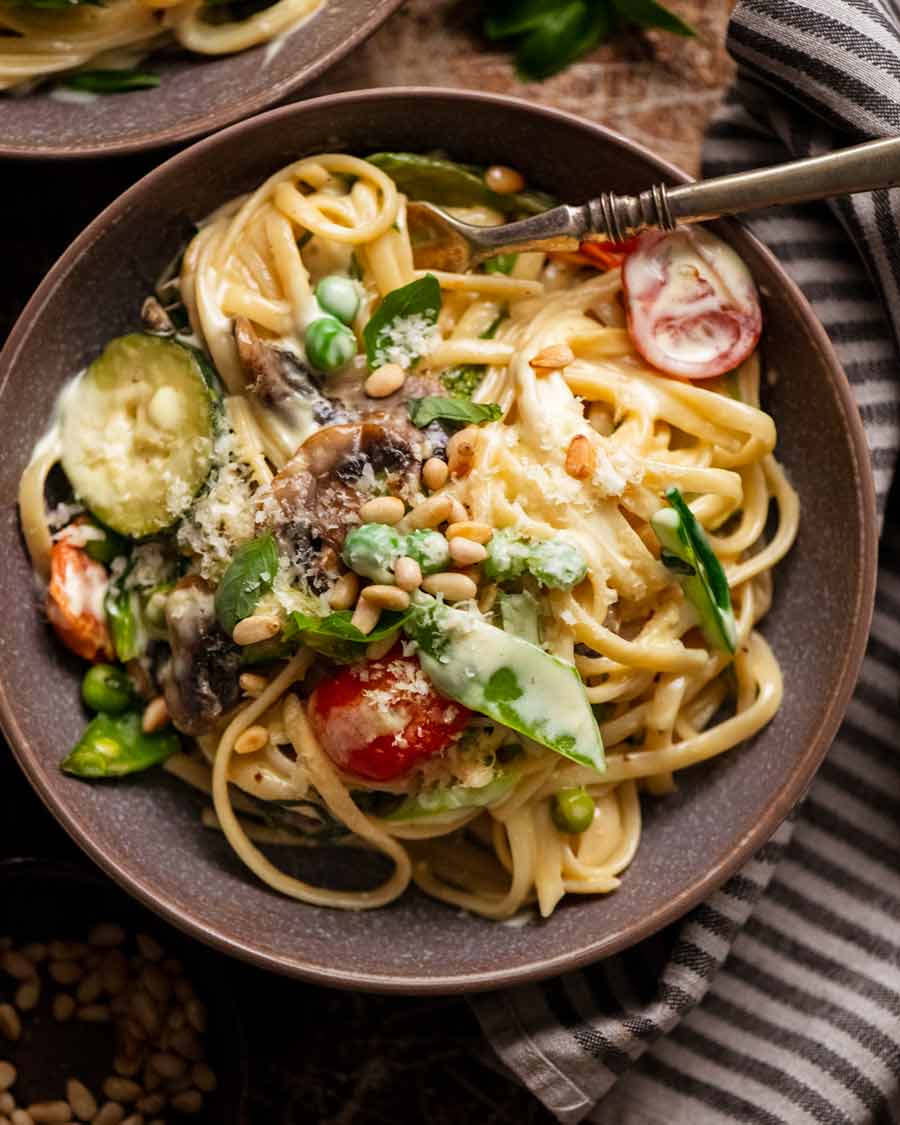
I actually filmed this recipe this time last year (Aussie spring 2021) but never got around to publishing the recipe because I put new recipes on pause while I worked on my cookbook. So my team and I have made it again just before sharing the recipe today to double check that it was still as good as we remembered.
And it is. I forgot how great this dish really is! I do hope you try it, no matter what season it is where you are. Because while it is hailed as a spring-celebration recipe, you really can make it all year round with whatever vegetables are in season! – Nagi x
Watch how to make it
Hungry for more? Subscribe to my newsletter and follow along on Facebook, Pinterest and Instagram for all of the latest updates.
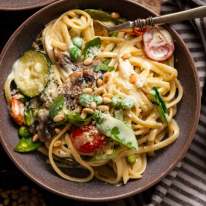
Pasta Primavera
Prep: 15 mins
Cook: 20 mins
Mains
American-Italian
Servings4
Tap or hover to scale
Instructions
Cut vegetables:
-
Broccolini – Cut off florets then cut in half lengthwise. Then slice the stems diagonally into 2.5 cm / 1″ lengths.
-
Snow peas – Remove the tough string running down the “seam” of the pea. Stack several peas and slice on the diagonal about 1cm / 0.4″ wide.
-
Asparagus – Snap the base off the asparagus, it will naturally break where the woody stem stars. Cut tips off, leave whole and set aside. Slice the stems diagonally into 2.5 cm / 1″ lengths.
Cream Sauce:
-
Melt butter in a saucepan over medium-high heat. Add cream and Parmigiano reggiano. Stir, and once the cream starts simmering gently, stir until the cheese melts then take it off the stove and set aside.
Pasta:
-
Bring a large pot of water to the boil over high heat. Add 1 tablespoon of salt and add the pasta. Cook for the time per the packet minus 1 minute. Meanwhile, cook vegetables.
-
Reserve pasta water: Just before draining the pasta, scoop out a mug of pasta cooking water and set aside. Drain the pasta.
Cook:
-
Mushrooms: Heat half the olive oil in a large skillet over high heat. Cook mushrooms for 4 minutes until golden, remove to a plate.
-
Veg: Heat remaining oil in the same skillet. Cook broccolini, snow peas and asparagus for 2 minutes. Add zucchini, tomato, green peas, garlic, salt and pepper. Cook for a further 3 minutes. Add mushroom back in, toss, then remove from heat.
-
Toss! Return pasta into the now-empty pot. Add vegetables, cream sauce and 1/3 cup pasta water. Toss over medium heat using 2 wooden spoons until the sauce thickens and clings to the pasta strands rather than pooling in the base of the pot, about 1 to 2 minutes. (If at any stage the pasta gets too thick, add a splash more pasta water and toss on stove).
-
Basil & pine nuts – Quickly toss through basil. Divide between 4 bowls. Sprinkle with pine nuts. Devour immediately!
Recipe Notes:
- Skip butter in Cream Sauce
- Skip all the oil
- Use 3 tbsp / 50g butter instead of oil for sautéing the vegetables
- Per serve nutrition: 145 calorie reduction, 17g less fat.
Still very, very tasty but not quite as luscious – of course!
1. Pasta – Use any long strand pasta you want. Short pasta (like penne) also works.
2. Vegetables – Feel free to substitute as you wish, make this your own! Either use other spring vegetables, or if you’re in a different season use whatever is seasonal. See in post for substitutions.
3. Cream – Any full fat cream will work just fine here. Low fat will work but the end result won’t be as luscious and the sauce will be thinner.
4. Parmigiano reggiano – Finely grate using microplane so it melts smoothly! Substitute with regular grade parmesan. Do not use store bought pre-grated parmesan as it won’t melt in the sauce.
5. No fresh basil? It’s still worth making! Try other soft herbs like roughly torn parsley, oregano, chervil or even mint. Otherwise add a squeeze of fresh lemon juice instead, to compensate with a different type of freshness.
6. Starchy pasta cooking water – The secret to thickening the cream sauce so it clings to every pasta strand and ends up in your mouth rather than a watery pool in the bottom of your bowl.
7. Toasted pine nuts – Toss raw pine nuts in a small skillet (no oil) over medium heat until it has light golden spots and smells nutty, about 2 minutes.
8. Nutrition per serving and worth every calorie, and remember there is lots of veg in this! But see top of Notes for how to lighten it up.
Nutrition Information:
Calories: 874cal (44%)Carbohydrates: 74g (25%)Protein: 23g (46%)Fat: 56g (86%)Saturated Fat: 27g (169%)Polyunsaturated Fat: 5gMonounsaturated Fat: 19gTrans Fat: 1gCholesterol: 116mg (39%)Sodium: 825mg (36%)Potassium: 776mg (22%)Fiber: 7g (29%)Sugar: 11g (12%)Vitamin A: 3166IU (63%)Vitamin C: 77mg (93%)Calcium: 276mg (28%)Iron: 4mg (22%)
Love creamy pastas?
Me too! Here are my favourites.
Life of Dozer
Dozer’s debut on TV as part of the cookbook publicity tour!! Is this really happening?? 😂 Watch him on Channel 10’s Studio 10 here.

His chef toque, hand made by the publicity manager at my publisher! (in the Uber en route to the studio 😂).
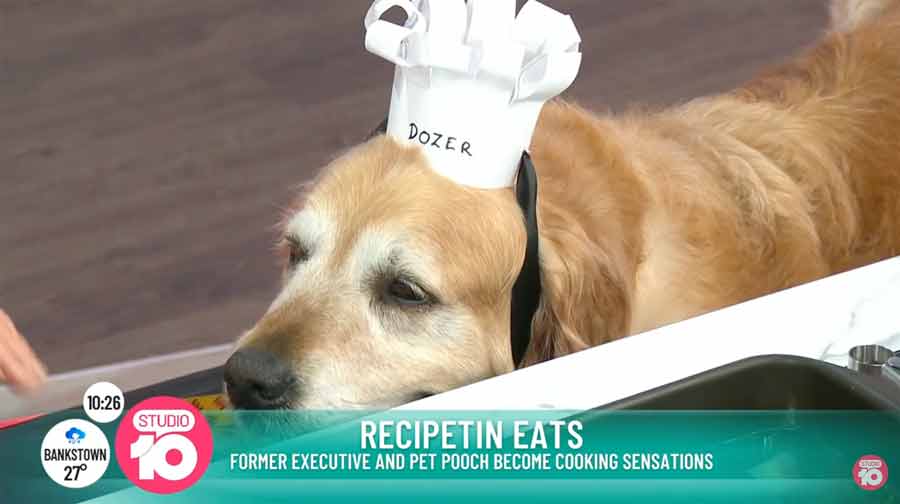
I did a cooking demo of the 12 Hour Slow Cooked Lamb…. wearing my lamb print skirt! Fashion faux pas??
